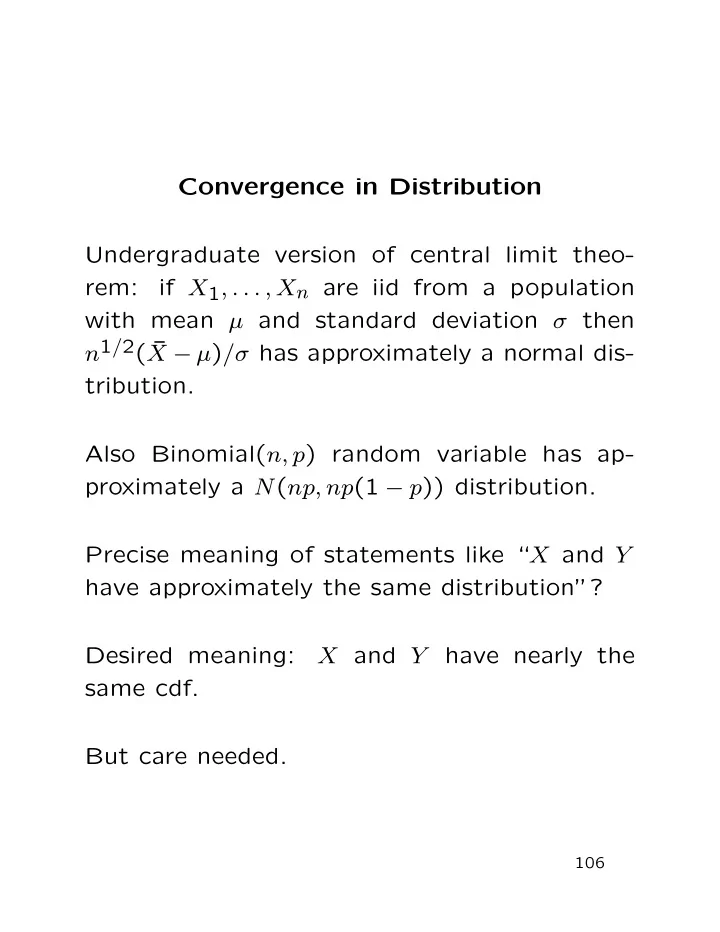

Convergence in Distribution Undergraduate version of central limit theo- rem: if X 1 , . . . , X n are iid from a population with mean µ and standard deviation σ then n 1 / 2 ( ¯ X − µ ) /σ has approximately a normal dis- tribution. Also Binomial( n, p ) random variable has ap- proximately a N ( np, np (1 − p )) distribution. Precise meaning of statements like “ X and Y have approximately the same distribution”? Desired meaning: X and Y have nearly the same cdf. But care needed. 106
Q1 ) If n is a large number is the N (0 , 1 /n ) distribution close to the distribution of X ≡ 0? Q2 ) Is N (0 , 1 /n ) close to the N (1 /n, 1 /n ) dis- tribution? Q3 ) Is N (0 , 1 /n ) close to N (1 / √ n, 1 /n ) distri- bution? Q4 ) If X n ≡ 2 − n is the distribution of X n close to that of X ≡ 0? 107
Answers depend on how close close needs to be so it’s a matter of definition. In practice the usual sort of approximation we want to make is to say that some random vari- able X , say, has nearly some continuous distri- bution, like N (0 , 1). So: want to know probabilities like P ( X > x ) are nearly P ( N (0 , 1) > x ). Real difficulty: case of discrete random vari- ables or infinite dimensions: not done in this course. Mathematicians’ meaning of close: Either they can provide an upper bound on the distance between the two things or they are talking about taking a limit. In this course we take limits. 108
Definition : A sequence of random variables X n converges in distribution to a random vari- able X if E ( g ( X n )) → E ( g ( X )) for every bounded continuous function g . Theorem 1 The following are equivalent: 1. X n converges in distribution to X . 2. P ( X n ≤ x ) → P ( X ≤ x ) for each x such that P ( X = x ) = 0 . 3. The limit of the characteristic functions of X n is the characteristic function of X : E ( e itX n ) → E ( e itX ) for every real t . These are all implied by M X n ( t ) → M X ( t ) < ∞ for all | t | ≤ ǫ for some positive ǫ . 109
Now let’s go back to the questions I asked: • X n ∼ N (0 , 1 /n ) and X = 0. Then 1 x > 0 P ( X n ≤ x ) → 0 x < 0 1 / 2 x = 0 Now the limit is the cdf of X = 0 except for x = 0 and the cdf of X is not continuous at x = 0 so yes, X n converges to X in distribution. • I asked if X n ∼ N (1 /n, 1 /n ) had a distribu- tion close to that of Y n ∼ N (0 , 1 /n ). The definition I gave really requires me to an- swer by finding a limit X and proving that both X n and Y n converge to X in distribu- tion. Take X = 0. Then E ( e tX n ) = e t/n + t 2 / (2 n ) → 1 = E ( e tX ) and E ( e tY n ) = e t 2 / (2 n ) → 1 so that both X n and Y n have the same limit in distribution. 110
Recommend
More recommend